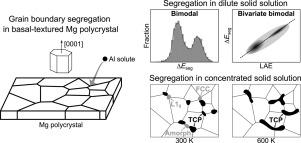Grain boundary segregation spectrum in basal-textured Mg alloys: From solute decoration to structural transition
IF 9.3
1区 材料科学
Q1 MATERIALS SCIENCE, MULTIDISCIPLINARY
引用次数: 0
Abstract
Mg alloys are promising lightweight structural materials due to their low density and excellent mechanical properties. However, their limited formability and ductility necessitate improvements in these properties, specifically through texture modification via grain boundary segregation. While significant efforts have been made, the segregation behavior in Mg polycrystals, particularly with basal texture, remains largely unexplored. In this study, we performed atomistic simulations to investigate grain boundary segregation in dilute and concentrated solid solution Mg–Al alloys. We computed the segregation energy spectrum of basal-textured Mg polycrystals, highlighting the contribution from specific grain boundary sites, such as junctions, and identified a newly discovered bimodal distribution which is distinct compared to the conventional skew-normal distribution found in randomly-oriented polycrystals. Using a hybrid molecular dynamics/Monte Carlo approach, we simulated segregation behavior at finite temperatures, identifying grain boundary structural transitions, particularly the varied fraction and morphology of topologically close-packed grain boundary phases when changing thermodynamic variables. The outcomes of this study offer crucial insights into basal-textured grain boundary segregation and phase formation, which can be extended to other relevant Mg alloys containing topologically close-packed intermetallics.


基底纹理镁合金中的晶界偏析谱:从溶质装饰到结构转变
镁合金具有低密度和优异的机械性能,是很有前途的轻质结构材料。然而,由于镁合金的可成形性和延展性有限,因此有必要通过晶界偏析来改善这些性能。尽管人们已经做出了巨大努力,但镁多晶体中的偏析行为,尤其是基底纹理中的偏析行为,在很大程度上仍未得到探索。在这项研究中,我们进行了原子模拟,以研究稀释和浓缩固溶体镁铝合金中的晶界偏析。我们计算了基底纹理镁多晶体的偏析能谱,强调了特定晶界位点(如接合点)的贡献,并确定了新发现的双峰分布,该分布与随机取向多晶体中发现的传统偏斜正态分布截然不同。利用分子动力学/蒙特卡洛混合方法,我们模拟了有限温度下的偏析行为,确定了晶界结构的转变,特别是改变热力学变量时拓扑紧密堆积晶界相的不同组分和形态。这项研究的成果为基底纹理晶界偏析和相的形成提供了重要的见解,并可将其推广到含有拓扑紧密堆积金属间化合物的其他相关镁合金。
本文章由计算机程序翻译,如有差异,请以英文原文为准。
求助全文
约1分钟内获得全文
求助全文
来源期刊

Acta Materialia
工程技术-材料科学:综合
CiteScore
16.10
自引率
8.50%
发文量
801
审稿时长
53 days
期刊介绍:
Acta Materialia serves as a platform for publishing full-length, original papers and commissioned overviews that contribute to a profound understanding of the correlation between the processing, structure, and properties of inorganic materials. The journal seeks papers with high impact potential or those that significantly propel the field forward. The scope includes the atomic and molecular arrangements, chemical and electronic structures, and microstructure of materials, focusing on their mechanical or functional behavior across all length scales, including nanostructures.
 求助内容:
求助内容: 应助结果提醒方式:
应助结果提醒方式:


